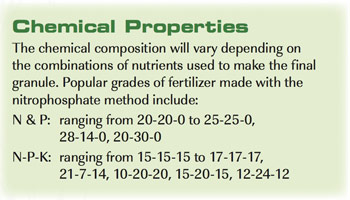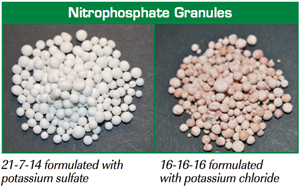The production and application of nitrophosphate fertilizers is largely regional, its use centered where this technology is advantageous. The process uses nitric acid instead of sulfuric acid for treating phosphate rock and doesn’t produce gypsum byproducts.
Production
The majority of commercial phosphorus (P) fertilizer is made by reacting raw phosphate rock with sulfuric or phosphoric acid. The sulfuric acid method of producing P fertilizer results in large amounts of calcium sulfate (gypsum) byproduct that incurs additional disposal costs.
Nitrophosphate production of P fertilizer differs because it involves reacting phosphate rock with nitric acid, which is made by oxidizing ammonia with air at high temperatures. A primary advantage of this method is that little or no sulfur (S) inputs are required. With the nitrophosphate process, excess calcium from the phosphate rock converts to valuable calcium nitrate fertilizer instead of gypsum. Norway pioneered the nitrophosphate method, and much of the global production still occurs in Europe.
The general reaction is:
Phosphate rock + Nitric acid à Phosphoric acid + Calcium nitrate + Hydrofluoric acid.
Manufacturers often mix the resulting phosphoric acid with other nutrients to form compound fertilizers containing several nutrients in a single pellet. They sell the cogenerated calcium nitrate or calcium ammonium nitrate separately as independent products.
Chemical properties

The nutrient combinations contained in the final granule determine the compound fertilizers’ chemical composition. Popular grades of fertilizer made with the nitrophosphate method include:
Agricultural use
Nitrophosphate fertilizers can contain a wide range of nutrients, depending on their intended use. It’s important growers select the proper composition for each specific crop and soil requirement. The granular form goes directly on the soil’s surface. It’s also commonly mixed within the root zone or applied as a concentrated band beneath the soil surface prior to planting.
Management practices

Nitrophosphate fertilizer contains varying amounts of ammonium nitrate, which attracts moisture. To prevent clumping or caking, manufacturers generally pack it in water-tight bags to protect it from moisture before delivery to the farmer.
Source: Nutrient Source Specifics (No. 15), International Plant Nutrition Institute.